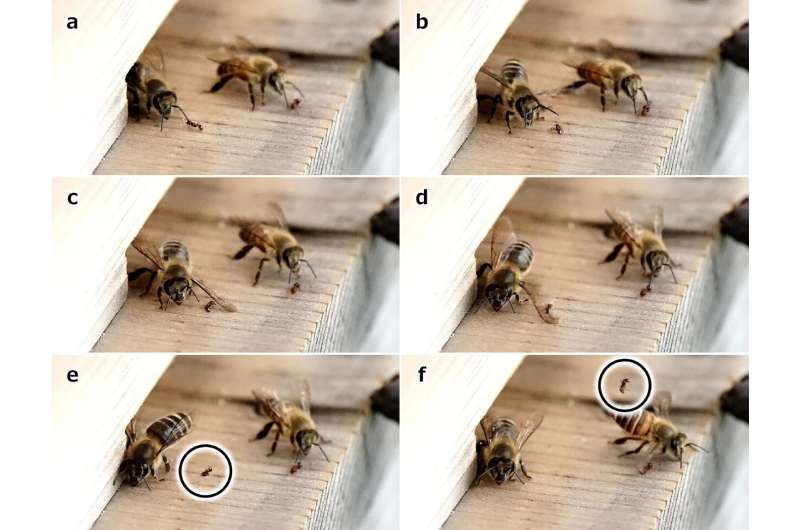July 17, 2024 report
This article has been reviewed according to Science X's editorial process and policies. Editors have highlighted the following attributes while ensuring the content's credibility:
fact-checked
peer-reviewed publication
trusted source
proofread
Japanese honeybees slap nest-invading ants with their wings to knock them away

A trio of environmental specialists at the National Institute for Environmental Studies, in Japan, has found that Japanese honeybees sometimes resort to slapping ants with their wings to prevent their entry into their nest.
In their study, published in the journal Ecology, Yugo Seko, Kiyohito Morii, and Yoshiko Sakamoto filmed a nest of honeybees using high-speed cameras and then analyzed the results in slow-motion.
Asian honeybees, known in Japan as Japanese honeybees, are known for their multipronged approach to guarding their nest. Prior research has shown that they use wing flapping to blow away pests, shimmering to confuse predators and stingers to injure them—they also sometimes form into balls to kill interlopers with their body heat. Some have even been found to build walls made of animal feces to ward off pests and predators.
In this new effort, the researchers found yet another way the bees repel small would-be invaders, such as ants—they smack them as hard as possible with one or both wings.
In the videos, the researchers could see that a guard bee clearly had slapping on its mind when approaching a small ant. It would not only pick up its pace as it moved in for the slap, but it would also lean back and twist, somewhat like a tennis player winding up for a very hard return. And then, it would slap the ant so hard that the much smaller creature would fly head over heels through the air, off the nest, and down to the ground below.
The researchers also noted that wing slapping was not always successful—sometimes the bee would miss the ant, though most often the ant would simply freeze, apparently unable to figure out how to proceed. That would leave it open to another slap or some wing flapping to push it off the nest.
The research team noted that the honeybees sometimes tried slapping bigger ants off the nest but were much less successful than with the smaller ants. They suggest the honeybees may have taken up wing slapping because it requires less energy than wing flapping.
More information: Yugo Seko et al, Wing‐slapping: A defensive behavior by honey bees against ants, Ecology (2024). DOI: 10.1002/ecy.4372
Journal information: Ecology
© 2024 Science X Network




















